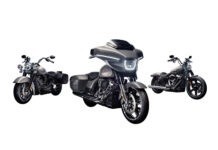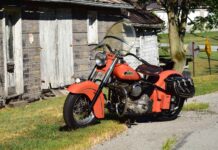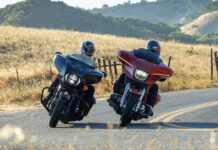Sturgis, S.D.—Heading north on Highway 79, I rode past Bear Butte in eerie silence, on a momentarily-empty stretch of tarmac. While an estimated 750,000 people partied on in the ancient tradition, I was celebrating the 75th Black Hills Classic test riding the 2016 Indian Chieftain under the thrall of the sacred mountain. It was a solemn moment, almost spiritual. And then I twisted the wick.

The Chieftain was first introduced to the public during a three-prong press launch (also in Sturgis) that included the 2014 Chief Classic and Chief Vintage. And while those two models were no major surprise, borrowing their looks largely from the Gilroy/Kings Mountain style of heavily-skirted fenders, the Chieftain was a totally unexpected beast complete with hard bags and a very real functional fairing. All three carried the newly-developed Thunder Stroke 111 engine that was first unveiled in March 2013 during Daytona Bike Week but had not found life in a working motorcycle until the 2014 models were released. Featuring 119 ft/lbs of torque, the engine achieved immediate respect, first from the media who were grateful to be provided the fodder to report on something truly revolutionary in the industry. The second level of respect came from customers eager to plop down the bucks for a badged Indian that was completely original and not simply an S&S clone.
And this burly (and handsome) powerplant remains just as impressive as when first revealed, delighting the rider with ample torque delivered over a broad rpm band. A joy to ride, the Thunder Stroke 111 allows the Indian Chieftain to remain a top contender in the American bagger market. It’s proven that popularity by finding a home in both the Indian Chief Dark Horse as well as the Indian Roadmaster, both launched in the last two years.

high-end power
The Thunder Stroke 111 is still cradled in a seven-piece cast aluminum frame that utilizes the engine as a stressed member. It’s a design that was well engineered from the beginning and as such, the chassis has experienced minimal changes over the last few years. It retains its original 25-degree rake as opposed to 29 degrees on the Classic and Vintage. The front suspension is the company’s venerable 46mm hydraulic unit with 4.7″ of travel while the rear bounce comes via an air-adjustable mono-shock with a rising rate link featuring a healthy 4.5″ of movement, the greatest offered in the Indian lineup. And when that powertrain, chassis and suspension are balanced between a pair of 16″ Dunlop Elite 3 tires (180/60 in the rear and a 130/90 up front) the result is a sure-footed ride even on washboard gravel at speed. The dry weight of 815 lbs., a seat height of 26″ and bars measuring a whopping 35″ across adds to the Chieftain’s stability and easy handling.

The fairing’s unique design offers recessed 4″ halogen spot lamps, integrated swept-wing turn signals and a beautiful chrome nacelle encompassing the halogen headlight. Instead of ending at the bottom of the headlamp assembly, the fairing features two panels that extend to the top of the lower fork legs. A power windscreen adjusts from a height of 8-3/4″ to 11-3/4″, slightly changing its angle in the process. And while 3″ of total travel doesn’t sound dramatic, the low, mid and high adjustment each offers the rider a totally unique riding experience—the opportunity to limit excess buffeting at high speeds or enjoy a wind-in-your-face ride. Although more than a novelty, the temptation to run it up and down at intersections while garnering the attention of fellow Sturgis riders was too great for the showoff kid in me to resist.

Once you fire up the ignition by pushing the big black button in the middle of the tank console (it’s a keyless system working in conjunction with a proximity fob), a litany of bells and whistles come to life but quickly disappear after the bike conducts a systems check. On the inner face of the fairing, the instrument panel presents an easy-to-read speedometer and tachometer with a fuel level gauge built into the tach. Between the speedo and tach is the info center that provides the time, ambient air temperature, radio information, odometer, fuel range, gear indicator (1–6) and tire pressure monitoring all accessed by a trigger on the backside of the left-hand switch module. But the clear plastic face that covers the entire instrument cluster causes a tremendous amount of glare in bright daylight that renders the information readout indecipherable.

Other controls are presented in a no-nonsense fashion and include cruise control, windscreen height toggle and all the switches for the AM/FM stereo (with weather band). The stereo also includes a media player and Pandora capabilities.
While no one predicted that Indian would attempt to meld a fairing and hard bags with the company’s iconic look, they surprised everyone when they accomplished just that. And although the saddlebags leave a little to be desired in the appearance department, they are roomy and serve the purpose of baggage storage well. These panniers remain a simple one-hand operation with a push-button release and a lift lip on top center. But the slickest feature of these spacious bags has to be the remote locking capability activated by a toggle on the dash. The electric lock mechanisms are housed in each bag’s lid and take up little space. Once again, the proximity fob comes into play when using this feature.

My only gripe about this bike would be the overkill on badging with at least two dozen “Indian” or “war bonnet” insignias ranging from seat conchos to floorboard inserts to engine castings.
When asked what was new for the 2016 Chieftain, the Indian representative answered, “Not much other than some new paint schemes.” (I test rode the Star Silver and Thunder Black model that carries a MSRP of $24,199, the only two-tone and also the highest-priced paint offering.) But that’s not to say the innovative minds at Indian are taking a respite. After positioning themselves well in the American bagger market, they refocused their direction and the results were a recently-released cruiser, the Chief Dark Horse, the liquid-cooled, 69 cubic inch Scout and the very brand new Scout 60. And I’m sure there are many more ideas being bandied about to address the projected needs of the consumer. As far as the Chieftain, it was a hit when first released and remains so due to Indian’s ability to breathe life into an iconic, history-rich (and almost dead) marque with enough engineering updates to fire the imagination and capture the attention of today’s modern motorcyclist—the best of both worlds.


the Chieftain’s fairing


















